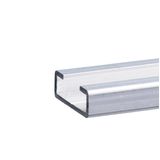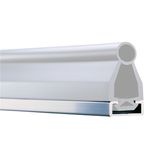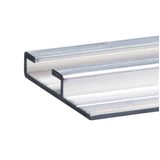Schmersal Cable bearing systems








schmersal cable bearing systems for plant and machine wiring
Engineers use this range to carry power and control runs cleanly from cabinets to machines while keeping separation, bend radii, and bonding under control. Materials include pre-galvanized steel (sendzimir), hot-dip galvanized after fabrication, powder-coated steel for indoor lines, and AISI 304/316 stainless for wash-down. Straight sections, bends, tees, reducers, and waterfall drop-outs share a unified hole pattern so hangers, splice bars, and dividers land in predictable positions across spans.
schmersal cable trays selection and load classes
Basket, ladder, and solid-bottom variants are offered to suit EMC, debris, and fill requirements. Typical tray widths run 50–600 mm with sidewalls 35–100 mm; tested load classes cover common spans of 1.5 m, 2.0 m, and 3.0 m. Where high fill or heavy VFD feeders are involved, ladder bodies with deep rungs handle higher kg/m ratings; mesh baskets simplify tie-off and 360° shield bonds near drives. Solid bottoms help with small-OD sensor leads and dust-sensitive lines. Accessories include splice plates, cantilever wall arms, thread-rod ceiling kits, drop-out radii, mid-span supports, and snap-in dividers for power/control segregation.
Product range and series overview
- Basket systems: fast cut-to-fit meshes with edge-safe wires; side couplers preserve earthing continuity without extra jumpers.
- Ladder systems: heavy-duty rungs for long spans above aisles or conveyors; perforations accept saddle clamps and U-bolts.
- Solid trays: continuous support for small conductors; perforated variants improve convection around power bundles.
- Fittings and terminations: inside/outside bends, tees, adjustable offsets, end boots, and radius “waterfalls” that protect jacket bend limits.
- Support program: wall arms, trapeze hangers, under-bench brackets, floor stands, seismic bracing kits, and drop-in anti-vibration pads.
Technical specifications and standards
Conformity follows IEC 61537 for cable management systems and IEC 60204-1 clearances in machine wiring. Protective bonding continuity is maintained through approved splice methods; dedicated PE jumpers are available where paint interrupts contact. Galvanizing thickness is specified per coating route; stainless parts use brushed or electropolished finishes for hygienic areas. Fasteners are 8.8 zinc-nickel plated or A2/A4 stainless; typical temperature window −25…+90 °C. Edge geometry is deburred to prevent jacket scoring; drop-outs respect minimum bend radii for servo and hybrid motor leads.
Applications and layout logic
Above cabinets, trays carry mains and VFD feeders; below gantries, baskets route sensor bundles toward islands and tap boxes. Over process lines, stainless ladder bodies resist detergents and steam; solid bottoms shield dusty packaging zones from fall-through debris. For retrofits, adjustable offsets and telescopic straights help clear existing pipework without new anchor points. Tie-off rules keep analog, safety, and high-dv/dt runs separated; dividers mark the boundaries so electricians can maintain spacing during later adds.
Mounting, bonding, and EMC practices
Use through-bolted wall arms on masonry and trapeze hangers on long runs; respect manufacturer span tables to avoid mid-span deflection. Bond every mechanical discontinuity; where paint exists, use serrated washers or dedicated bond straps. On VFD circuits, land shields with 360° clamps at the tray edge to minimize pigtail inductance and route the return path near the phase conductors. Keep transitions to flexible conduit short; support them with gland-side strain bars so terminal rows don’t carry cable weight.
Integration with brand sensors and controls
The program aligns with enclosure gland plates, junction boxes, and DIN terminals from the same catalog. Basket edges accept quick clamps that secure M8/M12 sensor leads near machine frames; ladder rungs accept saddle clamps sized for hybrid servo cables. This keeps labeling conventions, torque values, and IP claims consistent from tray to cabinet to machine.
B2B selection guidance for OEMs and integrators
Define environment first: powder-coated or pre-galv in dry halls, hot-dip for tough industrial air, stainless for CIP. Choose profile by load and EMC: basket for flexible tie-off and shield bonding, ladder for long spans and heavy bundles, solid for small-OD conductors and dust control. Confirm kg/m at your planned span, including 30 % reserve for future circuits. Reserve at least one divider lane for safety I/O. Standardize hardware: one hanger type, one splice plate family, one clamp style—fewer SKUs, faster installation.
Field wiring and service considerations
Pre-assemble trapeze kits to a fixed rod length and keep anchor centers on a 1 000 mm grid for drawing reuse. Place label plates at every fitting and above cabinet entries; match IDs to the cable schedule so technicians can trace circuits without opening duct. Where vertical drops enter machines, add strain bars and edge guards; this is where schmersal wire supports shorten maintenance time by eliminating ad-hoc brackets. For high-movement axes, leave a slack loop with a radius carrier and mark “no-add zone” tags to protect flex life.
Procurement notes and kitting
Bundle straight sections, fittings, hangers, fasteners, edge guards, dividers, and clamp sets per station. Keep spare splice plates and a small reel of bond braid in the service kit. For global builds, specify mixed hardware packs with both metric and anchor-specific thread inserts. Project teams often standardize widths (150/300/450 mm) so cutting and stocking are predictable—your BOM stays lean and repeatable.
Advantages of working with Bankoflamps
Bankoflamps aligns pricing to your BOM and exposes real-time stock across EU warehouses before you lock the schedule. Quote responses arrive fast—around an hour in typical cases—so install windows don’t slip. Ordering by EAN/MPN keeps variants under control; your portal shows lead times, shipment status, and downloadable price lists for budgeting. Approved partners use post-payment up to 30 days. We group partials into consolidated shipments and hold price-validity windows, which keeps phased rollouts predictable. Your account manager validates spans, coatings, and clamp sets against your drawings so the kit lands correct the first time.